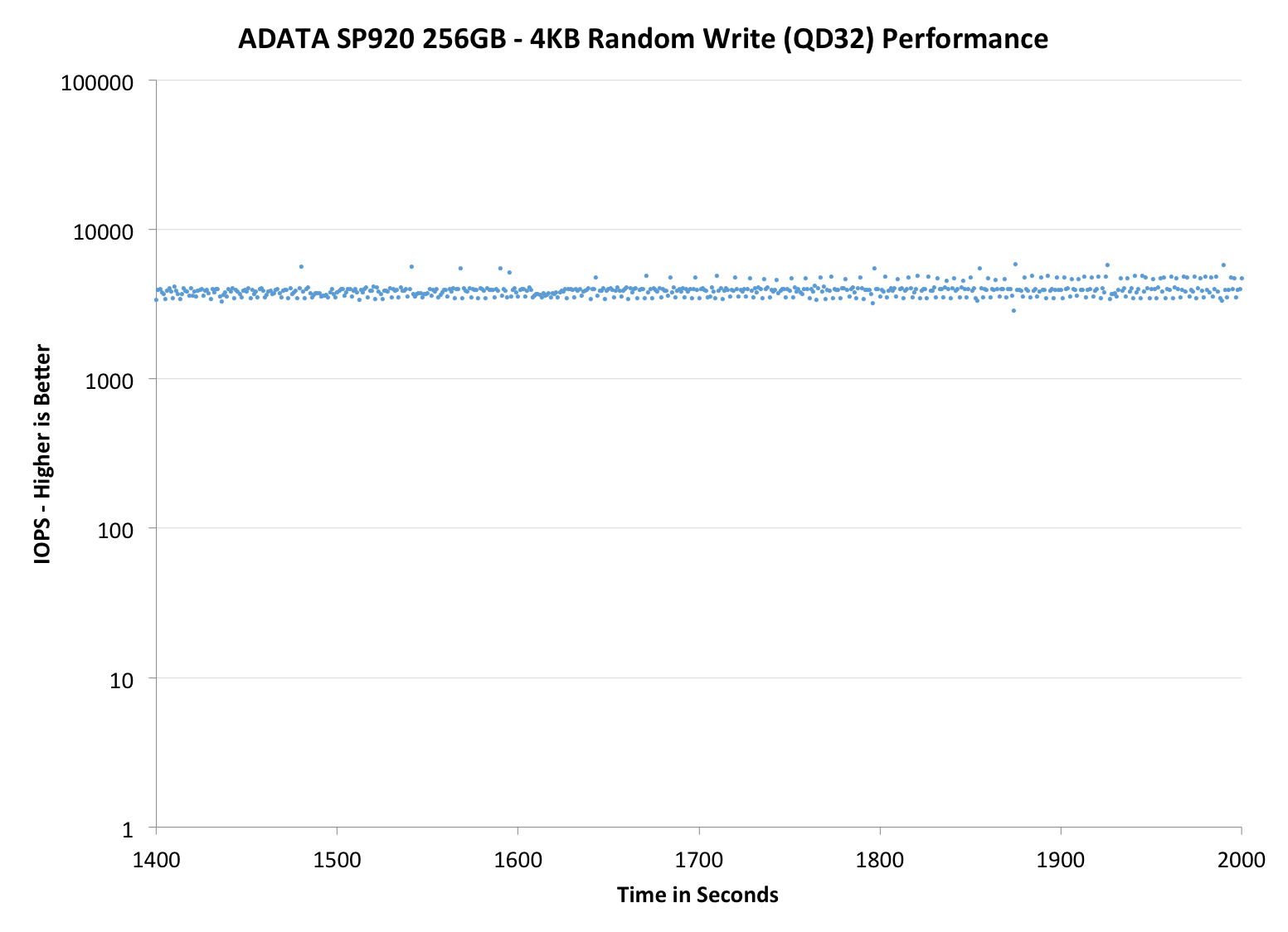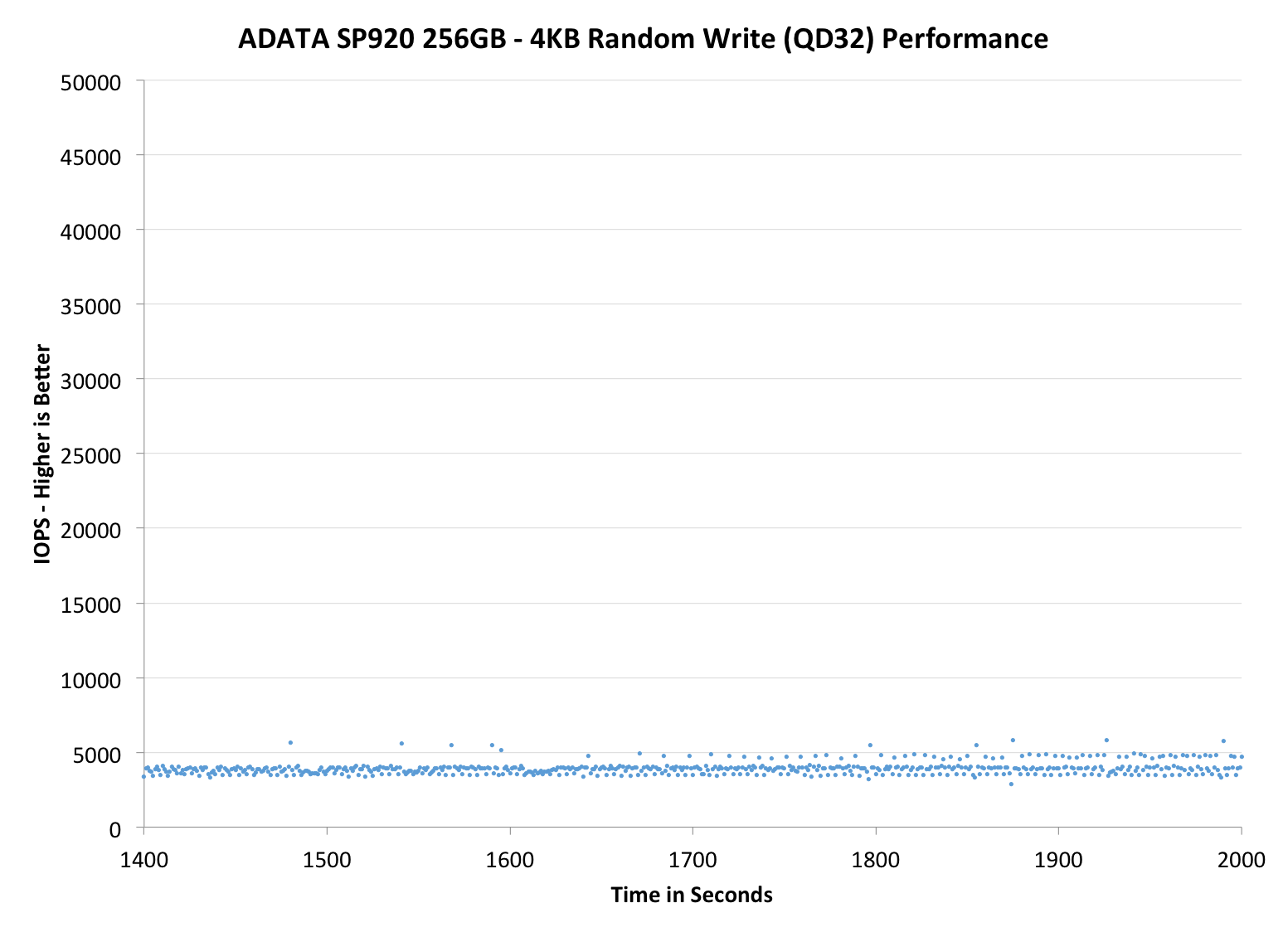ADATA SP920 (128GB, 256GB, 512GB & 1TB) Review
by Kristian Vättö on April 1, 2014 8:30 PM ESTPerformance Consistency
Performance consistency tells us a lot about the architecture of these SSDs and how they handle internal defragmentation. The reason we don’t have consistent IO latency with SSD is because inevitably all controllers have to do some amount of defragmentation or garbage collection in order to continue operating at high speeds. When and how an SSD decides to run its defrag or cleanup routines directly impacts the user experience as inconsistent performance results in application slowdowns.
To test IO consistency, we fill a secure erased SSD with sequential data to ensure that all user accessible LBAs have data associated with them. Next we kick off a 4KB random write workload across all LBAs at a queue depth of 32 using incompressible data. The test is run for just over half an hour and we record instantaneous IOPS every second.
We are also testing drives with added over-provisioning by limiting the LBA range. This gives us a look into the drive’s behavior with varying levels of empty space, which is frankly a more realistic approach for client workloads.
Each of the three graphs has its own purpose. The first one is of the whole duration of the test in log scale. The second and third one zoom into the beginning of steady-state operation (t=1400s) but on different scales: the second one uses log scale for easy comparison whereas the third one uses linear scale for better visualization of differences between drives. Click the buttons below each graph to switch the source data.
For more detailed description of the test and why performance consistency matters, read our original Intel SSD DC S3700 article.
 |
|||||||||
| ADATA SP920 | Crucial M550 | Intel SSD 730 | SanDisk Extreme II | Samsung SSD 840 EVO | |||||
| Default | |||||||||
| 25% Spare Area | - | ||||||||
As expected, the IO consistency is the same as in the M550 and even the capacity variations and over-provisioning behavior match. Like I said in the M550 review, I'm not very satisfied with the IO consistency compared to what we've seen lately but at least ADATA is positioning the SP920 as a mainstream value drive.
 |
|||||||||
| ADATA SP920 | Crucial M550 | Intel SSD 730 | SanDisk Extreme II | Samsung SSD 840 EVO | |||||
| Default | |||||||||
| 25% Spare Area | - | ||||||||
 |
|||||||||
| ADATA SP920 | Crucial M550 | Intel SSD 730 | SanDisk Extreme II | Samsung SSD 840 EVO | |||||
| Default | |||||||||
| 25% Spare Area | - | ||||||||
TRIM Validation
To test TRIM, I took a secure erased 128GB SP920 and filled it with sequential data. Then I tortured the drive with 4KB random writes (QD32) for 40 minutes followed by a TRIM command (quick format in Windows). Finally I measured performance with HD Tach to bring you the graph below:
And as you should expect, TRIM works.











30 Comments
View All Comments
Samus - Wednesday, April 2, 2014 - link
Marvell controllers are just simpler than Sandforce (which is a good thing)Marvell has eDrive support in their newer controllers, simpler firmware, lower power usage, and no compression technology (making the implementation simple and performance consistent)
I prefer Marvell and Intel controllers over everyone else's but some newer controllers have looked promising (like OCZ's Barefoot)
Kristian Vättö - Thursday, April 3, 2014 - link
Marvell only provides the silicon - the firmware development is up to the manufacturer.hojnikb - Wednesday, April 2, 2014 - link
It's interesting to see that lower capacity versions perform better than m500, despite using the same die size flash. Is this because of the updated controller or more aggressive flash programming ?Samus - Wednesday, April 2, 2014 - link
They have the m550 controller but use the m500's NAND technology so the lower capacity drives are in between the m500 and m550 in performance.Kristian Vättö - Thursday, April 3, 2014 - link
Likely just better optimization at the firmware level.hojnikb - Thursday, April 3, 2014 - link
So in theory, they could update the m500 and boost it's, if they wanted ?hojnikb - Thursday, April 3, 2014 - link
*write speed, silly me :)(damn no edit option)
nick2crete - Wednesday, April 2, 2014 - link
Well ,i prefer to deal with Crucial than Adata even overseas where i am ..Hubb1e - Wednesday, April 2, 2014 - link
I just wanted to let the writer and editorial staff know that a good number of people skip right to the end of the article for the normal recap of the article's main points. This is especially true for SSD articles which IMO are getting to be a commodity and aren't all that interesting anymore. I felt that the final words didn't do a good job of recapping where this drive stands in the overall SSD segment, didn't give much in the way of a pro/cons for this drive, and refereed too much to a comparison with a drive that I don't know much about. This seems like a new writer so I wanted to let the staff know about my opinion on this so he can improve his next article for Anandtech.mcnaughty - Wednesday, April 2, 2014 - link
Totally agreed. Skip the waffle, we regular readers know all this already. Give us the numbers, and the interesting differences.